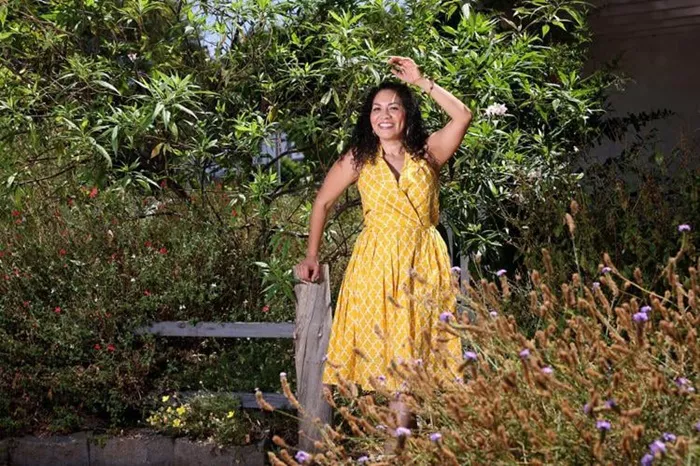LOS ANGELES — In a city once known for its water-thirsty lawns, a new trend is emerging: sustainable, low-water landscaping. This shift is exemplified by Aurora Anaya’s transformation of her Whittier garden into a vibrant, eco-friendly oasis.
When Anaya purchased her Art Deco home on a corner lot in Whittier, she envisioned a garden that would reflect her values. Her journey began with a chance encounter at a farmer’s market, where she learned about the importance of milkweed for endangered monarch butterflies.
“I left that conversation with my first milkweed plant and the ‘Drought Tolerant Garden’ handbook from Los Angeles County,” Anaya recalled in a recent email. “I discovered the benefits of native plants and was instantly hooked.”
Today, Anaya’s yard is a haven for pollinators like hummingbirds, bees, and monarch butterflies. She replaced the traditional lawn with a garden featuring California native plants, creating a dynamic ecosystem that supports these important creatures.
The garden thrives even in late summer, a time when many native shrubs have finished blooming. Despite this, flowers still abound, including the violet tips of De La Mina verbena, the deep-throated blooms of the Pink Dawn Chitalpa tree, and the soft orange flowers of Palmer’s Indian mallow. The standout feature is her stands of narrow leaf milkweed, which have grown nearly five feet tall and are essential for monarch reproduction.
Although the garden’s color palette changes throughout the year, Anaya’s commitment to maintaining visual interest remains steadfast. She told Cameron de Anda, manager of the Los Angeles Parks Foundation’s native plant nursery, that she wanted her garden to have year-round appeal.
“This goal has been achieved,” Anaya said. “Something is always blooming, even during the summer dormancy period when many native plants go brown or die back to conserve water.”
De Anda noted that the summer dormancy, similar to winter dormancy in colder climates, often surprises new gardeners. He recalled a relative who found the brown, dormant plants unattractive, but explained, “It’s not ugly; it’s just waiting for rain. Many people mistake dormancy for dead plants, not realizing they will revive once the rains return.”
Anaya’s enthusiasm for native gardening has been a significant part of her life since she bought her home in early 2021. She delved deeply into learning about native plants, taking classes, following relevant social media accounts, and visiting various gardens.
Her dedication was solidified during the Theodore Payne Foundation’s Native Plant Garden Tour in spring 2022. She participated in the San Gabriel Valley Water Co.’s Create Your Garden program, which offers financial assistance for replacing lawns with drought-tolerant landscapes. Anaya collaborated with de Anda to design her new garden, investing around $5,000 for installation and plant materials.
The project included removing 763 square feet of lawn, installing a drip irrigation system, and planting a variety of native species. The transformation required significant effort but resulted in unexpected community connections. Neighbors who initially just waved began stopping to chat, offering encouragement and expressing appreciation for the garden’s beauty.
Anaya also started sharing seeds and offering garden tours through the Whittier Buy Nothing group, further engaging with her community. Her garden flourished in spring 2023, prompting her to turn her attention to the backyard, where she plans to grow vegetables and add more fruit trees.
Her latest project involves a mobile store for native plants and related books, reflecting her ongoing passion for education and community engagement. Anaya, who grew up in Boyle Heights and founded La Casa Azul Bookstore in New York City, has returned to Los Angeles with a renewed focus on her roots and garden.
While not all plants in her garden are native, her thoughtful selection includes some non-native species known for their beauty and low-water needs, such as Spanish lavender and bougainvillea. Her mother proudly shows off the garden, and her nieces often help with the upkeep.
For Anaya, her garden represents more than just an environmental effort. It has become a source of personal fulfillment, providing stress relief and a deeper connection to her community and nature. “The sensory overload of working in the garden is overwhelmingly positive,” she said, reflecting on the joy of observing hummingbirds and butterflies while tending to her plants.


